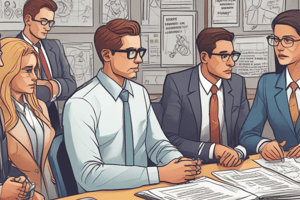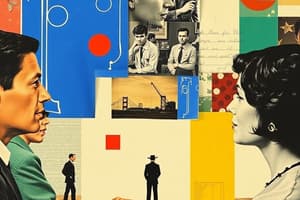Podcast
Questions and Answers
Which of the following scenarios best illustrates the application of Organizational Behavior (OB) principles in improving business performance?
Which of the following scenarios best illustrates the application of Organizational Behavior (OB) principles in improving business performance?
- A company invests in new machinery to increase production output.
- A manager uses team-building activities to improve communication and collaboration among team members. (correct)
- A marketing team launches a new advertising campaign targeting a younger demographic.
- A company implements a new accounting software to streamline financial processes.
An organization is undergoing a significant restructuring. How can an understanding of the three levels of OB analysis best assist in managing this change effectively?
An organization is undergoing a significant restructuring. How can an understanding of the three levels of OB analysis best assist in managing this change effectively?
- By addressing individual reactions to change, group dynamics during the transition, and the overall impact on organizational culture. (correct)
- By prioritizing the group level to ensure teams remain intact and continue to function efficiently.
- By focusing solely on the organizational level to redesign the company's hierarchy and policies.
- By ignoring individual concerns and focusing on the strategic advantages of the new structure.
In the context of organizational elements, which action exemplifies leveraging informal elements to achieve organizational goals?
In the context of organizational elements, which action exemplifies leveraging informal elements to achieve organizational goals?
- Redesigning job descriptions to clarify roles and responsibilities.
- Encouraging social networks to share knowledge and best practices across departments. (correct)
- Implementing a strict attendance policy to reduce absenteeism.
- Enforcing a formal dress code to promote a professional image.
Which modification to a company’s performance review process would most effectively apply a lesson learned from the Hawthorne Studies?
Which modification to a company’s performance review process would most effectively apply a lesson learned from the Hawthorne Studies?
A company is expanding into a country with a high power distance culture. Which of these strategies would be most effective for managing employees in that location, according to Hofstede's dimensions?
A company is expanding into a country with a high power distance culture. Which of these strategies would be most effective for managing employees in that location, according to Hofstede's dimensions?
An organization aims to foster a more inclusive environment. Which approach would most directly address the difference between diversity and inclusion?
An organization aims to foster a more inclusive environment. Which approach would most directly address the difference between diversity and inclusion?
How does applying the concept of equity, as distinct from equality, lead to a fairer outcome in a workplace scenario?
How does applying the concept of equity, as distinct from equality, lead to a fairer outcome in a workplace scenario?
Which scenario illustrates how a perceiver's characteristics might influence social perception in the workplace?
Which scenario illustrates how a perceiver's characteristics might influence social perception in the workplace?
An HR department is trying to reduce the impact of the beauty bias in the hiring process. Which of the following strategies would directly address this bias?
An HR department is trying to reduce the impact of the beauty bias in the hiring process. Which of the following strategies would directly address this bias?
A team leader consistently dismisses ideas from junior team members, favoring those from more experienced colleagues. Which barrier to social perception is most evident in this situation?
A team leader consistently dismisses ideas from junior team members, favoring those from more experienced colleagues. Which barrier to social perception is most evident in this situation?
An employee who is highly conscientious is likely to demonstrate which behavior in the workplace?
An employee who is highly conscientious is likely to demonstrate which behavior in the workplace?
A manager attributes a project failure to a lack of effort on the part of the team, disregarding the impact of unforeseen technical difficulties. Which attribution error is the manager most likely committing?
A manager attributes a project failure to a lack of effort on the part of the team, disregarding the impact of unforeseen technical difficulties. Which attribution error is the manager most likely committing?
Following a negative customer interaction, a sales representative experiences frustration (affect), avoids future interactions with customers (behavior), and believes that customers are generally unreasonable (cognition). Which component of the ABC model does the 'belief that customers are generally unreasonable' represent?
Following a negative customer interaction, a sales representative experiences frustration (affect), avoids future interactions with customers (behavior), and believes that customers are generally unreasonable (cognition). Which component of the ABC model does the 'belief that customers are generally unreasonable' represent?
An employee is considering leaving their job because they feel emotionally connected to their team and the company's mission. Which type of organizational commitment is this employee demonstrating?
An employee is considering leaving their job because they feel emotionally connected to their team and the company's mission. Which type of organizational commitment is this employee demonstrating?
During a busy period, a team member voluntarily stays late to help colleagues complete their tasks, even though it's not required. Which behavior is this team member demonstrating?
During a busy period, a team member voluntarily stays late to help colleagues complete their tasks, even though it's not required. Which behavior is this team member demonstrating?
A customer service representative is trained to express empathy and concern, regardless of their true feelings. If the representative genuinely attempts to feel the emotions they are displaying, what type of emotional labor are they practicing?
A customer service representative is trained to express empathy and concern, regardless of their true feelings. If the representative genuinely attempts to feel the emotions they are displaying, what type of emotional labor are they practicing?
A company decides to lay off a large number of employees to increase profits, arguing that it will benefit shareholders and ensure the company's long-term survival. Which ethical framework is primarily being used to justify this decision?
A company decides to lay off a large number of employees to increase profits, arguing that it will benefit shareholders and ensure the company's long-term survival. Which ethical framework is primarily being used to justify this decision?
An employee consistently manipulates colleagues to gain promotions and advantages, showing a disregard for ethical considerations. This behavior is most indicative of which personality trait?
An employee consistently manipulates colleagues to gain promotions and advantages, showing a disregard for ethical considerations. This behavior is most indicative of which personality trait?
An employee is assigned a challenging project. If this employee demonstrates high intensity in their motivation, how would this manifest in their work?
An employee is assigned a challenging project. If this employee demonstrates high intensity in their motivation, how would this manifest in their work?
According to Herzberg’s Two-Factor Theory, which adjustment is most likely to improve your employees' job satisfaction, and motivate them?
According to Herzberg’s Two-Factor Theory, which adjustment is most likely to improve your employees' job satisfaction, and motivate them?
Flashcards
Organizational Behavior (OB)
Organizational Behavior (OB)
The field that studies how individuals, groups, and structures impact behavior within organizations to improve effectiveness.
3 Levels of OB Analysis
3 Levels of OB Analysis
Personal characteristics (like personality), group dynamics (like teamwork), and organizational aspects (like culture).
Hawthorne Effect
Hawthorne Effect
The alteration of behavior by study participants due to their awareness of being observed.
Formal Elements
Formal Elements
Signup and view all the flashcards
Informal Elements
Informal Elements
Signup and view all the flashcards
Power Distance
Power Distance
Signup and view all the flashcards
Individualism vs. Collectivism
Individualism vs. Collectivism
Signup and view all the flashcards
Masculinity vs. Femininity
Masculinity vs. Femininity
Signup and view all the flashcards
Uncertainty Avoidance
Uncertainty Avoidance
Signup and view all the flashcards
Long-term vs. Short-term Orientation
Long-term vs. Short-term Orientation
Signup and view all the flashcards
Diversity
Diversity
Signup and view all the flashcards
Inclusion
Inclusion
Signup and view all the flashcards
Equity
Equity
Signup and view all the flashcards
Equality
Equality
Signup and view all the flashcards
Perceiver's Characteristics
Perceiver's Characteristics
Signup and view all the flashcards
Projection
Projection
Signup and view all the flashcards
Conscientiousness
Conscientiousness
Signup and view all the flashcards
Fundamental Attribution Error
Fundamental Attribution Error
Signup and view all the flashcards
Cognitive Dissonance
Cognitive Dissonance
Signup and view all the flashcards
Organizational Citizenship Behaviors (OCBs)
Organizational Citizenship Behaviors (OCBs)
Signup and view all the flashcards
Study Notes
Chapter 1: Organizational Behavior (OB)
- Organizational Behavior (OB) aids in understanding, predicting, and influencing human behavior within organizations.
- OB enhances workplace effectiveness, job satisfaction, and business performance.
- OB studies the impact of individuals, groups, and structures on behavior within organizations, with the goal of improving organizational efficiency, employee engagement, and leadership effectiveness.
- The three levels of OB analysis are: Individual, Group, and Organizational.
- The Individual level focuses on personal characteristics like personality, motivation, and perception.
- The Group level examines teamwork, leadership, and communication.
- The Organizational level considers company culture, policies, and structure.
- Formal elements include structure, policies, job descriptions, and goals.
- Informal elements include culture, personal relationships, social networks, and norms.
- The Hawthorne Studies demonstrated that employees perform better when they feel valued and observed, which created the term the "Hawthorne Effect".
- The Hawthorne Effect means people change their behavior when they know they are being watched.
Chapter 2: Cultural Differences & Diversity
- Hofstede's 5 Dimensions of Cultural Differences are: Power Distance, Individualism vs. Collectivism, Masculinity vs. Femininity, Uncertainty Avoidance, and Long-term vs. Short-term Orientation.
- Power Distance is the degree to which less powerful members accept unequal power distribution.
- Individualism vs. Collectivism focuses on personal goals versus group goals.
- Masculinity vs. Femininity refers to competitive versus cooperative cultural values.
- Uncertainty Avoidance is how much a society tolerates uncertainty and risk.
- Long-term vs. Short-term Orientation focuses on future rewards versus immediate outcomes.
- Diversity refers to demographic differences such as race, gender, and culture.
- Inclusion involves creating an environment where diverse individuals feel valued and included.
- Cox & Blake’s reasons for valuing diversity include: cost advantage, attracting talent, marketing benefits, creativity & innovation, problem-solving improvements, and system flexibility.
- Equality means treating everyone the same.
- Equity means giving people resources based on their needs to ensure fairness.
Chapter 3: Perception & Personality
- The three factors that Influence Social Perception are: Perceiver’s characteristics, Target’s characteristics, and Situational characteristics.
- The Perceiver's characteristics include attitudes, experiences, and expectations.
- The Target's characteristics include physical appearance and verbal communication.
- The Situational characteristics include context and background.
- Beauty Bias describes when people associate physical attractiveness with competence and success.
- Barriers to Social Perception include: selective perception, stereotyping, first-impression error, projection, and self-fulfilling prophecy.
- Selective Perception is seeing what aligns with your beliefs.
- Stereotyping is generalizing a trait to an entire group.
- First-Impression Error is judging based on initial impressions.
- Projection is assuming others share your views.
- Self-Fulfilling Prophecy is allowing expectations to influence behavior, causing predictions to come true.
- The Big Five Personality Traits are: Openness, Conscientiousness, Extraversion, Agreeableness, and Neuroticism.
- Openness means creativity and willingness to try new things.
- Conscientiousness means being organized, responsible, and dependable, and is the best predictor of job performance.
- Extraversion means sociability and assertiveness.
- Agreeableness is a cooperative and compassionate nature.
- Neuroticism is emotional stability versus anxiety and mood swings.
- Internal Attribution is the assessment that behavior is due to personal traits.
- External Attribution is the assessment that behavior is due to situational factors.
- The Fundamental Attribution Error is overemphasizing personal traits and underestimating the situation.
- Self-Serving Bias is attributing successes to oneself and failures to external factors.
Chapter 4: Attitudes, Emotions & Ethics
- Attitudes are beliefs or feelings influencing behavior.
- The ABC Model includes: Affect (emotional response), Behavior (how we act), and Cognition (beliefs or thoughts).
- Cognitive Dissonance is mental discomfort when behavior and attitudes conflict.
- Job Satisfaction is influenced by pay, the work itself, coworkers, opportunities, and supervision.
- The 3 types of Organizational Commitment are: Affective, Continuance, and Normative.
- Affective commitment involves emotional attachment.
- Continuance commitment involves staying due to costs of leaving.
- Normative commitment involves feeling obligated to stay.
- Organizational Citizenship Behaviors (OCBs) are extra, voluntary actions that benefit the company.
- Counterproductive Work Behaviors (CWBs) are harmful actions like theft or sabotage.
- Emotions are short-term, specific reactions.
- Moods are longer-lasting, general feelings.
- Emotional Labor involves managing emotions at work.
- Deep Acting is truly feeling the emotions you express.
- Surface Acting is faking emotions.
- Ethical Behavior involves doing what is morally right.
- The three theories of ethics are Consequential, Rule-Based, and Character.
- Consequential ethics (utilitarianism) means outcomes determine morality.
- Rule-Based ethics (deontology) means following universal principles.
- Character ethics (virtue ethics) means morality is based on personal integrity.
- Machiavellianism is manipulative, self-serving behavior.
Chapter 5: Motivation at Work
- Motivation is the force driving effort, characterized by direction (what we choose to do), intensity (how much effort we put in), and persistence (how long we sustain effort).
- Maslow’s Hierarchy of Needs includes: Physiological, Safety, Love/Belonging, Esteem, and Self-Actualization.
- Physiological needs are food and shelter.
- Safety needs are security.
- Love/Belonging needs are relationships.
- Esteem needs are recognition.
- Self-Actualization is personal growth.
- McGregor’s Theory X says people dislike work and need control.
- McGregor’s Theory Y says people enjoy work and seek responsibility.
- Herzberg’s Two-Factor Theory involves motivation factors and hygiene factors.
- Motivation factors include achievement and recognition.
- Hygiene factors include salary and conditions, which prevent dissatisfaction but don’t inherently motivate.
- Goal-Setting Theory involves SMART Goals: Specific, Measurable, Achievable, Relevant, and Time-bound.
- Equity Theory (Adams) states motivation depends on fairness in effort/reward ratios.
- Equity is a fair balance.
- Negative Inequity is feeling underpaid.
- Positive Inequity is feeling overpaid.
- Expectancy Theory includes: Expectancy, Instrumentality, and Valence.
- Expectancy is the belief that effort leads to performance.
- Instrumentality is the belief that performance leads to reward.
- Valence is the value of the reward.
Studying That Suits You
Use AI to generate personalized quizzes and flashcards to suit your learning preferences.




